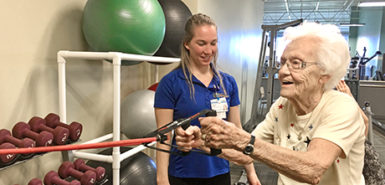
Got back pain?
You don’t need expensive devices like shoe inserts and back belts to tame your pain.
Experts are discovering a simple and free fix: exercise.
“By and large, my perspective is that movement heals the body,” said Joy Powell, a Spectrum Health Outpatient Rehabilitation physical therapist certified in Mechanical Diagnosis and Therapy of the Spine. “The more an individual can move, the better off they’re going to be.”
But it’s a bit of a double-edged sword, according to Powell. The wrong movements could aggravate an injury.
“People can perpetuate pain by doing inappropriate exercise or moving inappropriately while doing the right exercise,” she said.
According to a recent study published in JAMA Internal Medicine, exercise can reduce the risk of repeated lower back pain in the year following an episode by 25 to 40 percent.
Core strengthening, aerobics and flexibility and stretching exercises all help, according to the study, while devices such as back belts and shoe insoles did little to lessen back pain.
But Powell said some gadgets are beneficial for short-term use, with the operative word being “short-term.”
“I think to some degree those products provide support that our body should inherently provide but can’t anymore,” Powell said. “Some individuals do have structural variances in their anatomy that would require the use of some support.”
Powell believes back braces can be helpful during fresh pain that limits mobility or function in order to allow a person to continue performing daily activities instead of choosing bed rest or sitting.
“Pain can prohibit the muscles from firing,” Powell said. “Get past the inflammatory phase, which can last for the first five days and get out of the brace as soon as possible because the brace will take over for what your muscles are supposed to do and your muscles will just get lazy.”
The easiest and best cure for back pain is to avoid it in the first place.
Here’s what Powell recommends:
• Get up and move. Even if you work a desk job, stand up every hour for two to five minutes.
• Walk to the printer. Instead of collecting all of your printouts at the end of the day, walk to the printer each time you print a document.
• Fill up your water bottle frequently.
• Ask for a good office chair—one that supports your body alignment at 90 degree angles. “People are afraid to speak up and advocate for themselves,” Powell said. “If you don’t have a great chair, ask for a different one.”
• If your feet don’t touch the floor when you sit, use a step stool under your feet.
• Exercise within your capacity. If your goal is to run a marathon, don’t start out running five miles the first day. Ease into your training gradually. “A lot of people go full-tilt boogie from the get-go,” Powell said. “They think they can do what they did five or 10 years ago. They get discouraged, burned out and they stop.”
• Swim or exercise in water. “Even if you’re not a good swimmer, doing leg movements or squatting is beneficial,” Powell said.
• Pick a sport or exercise that’s familiar to your body. Your muscles will remember, which could help reduce injury risk.
• Find something you like and that you’ve done in the past that you’re good at. “Those muscle-firing patterns are going to remember how they used to act,” Powell said, “and they’ll come back, versus trying to do something you haven’t done before.”
• Remain dedicated to movement. “Nothing will work unless you do,” she said. “It’s going to take effort and time, but nothing comes easily. It always requires something in return.”
 /a>
/a>
 /a>
/a>
 /a>
/a>
Very informative, but mostly supportive and energizing.
Thank you, Sondra! We’re glad to offer up inspiring health news you can use! 🙂